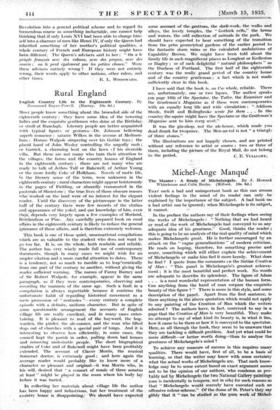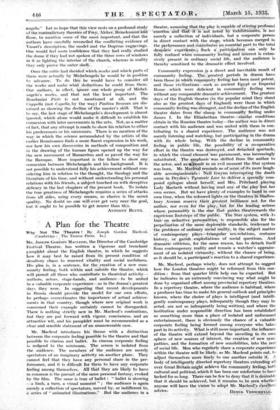MichellAn . ge Manque TUAT such a bad and unimportant book
as this can arouse violent feelings in the mind 'of its reader can only be explained by the importance of the subject. A bad hook bn a bad artist can be ignored ; when Michelangelo is its subject, it cannot In the preface the authors say of their feelings when seeing the works of Michelangelo : "Nothing that we had heard or read of the work of Michelangelo had conveyed to us any adequate idea of his greatness." Good, thinks the reader ; this is going to be an analysis of the real quality of mind which makes Michelangelo great. He is further encouraged by an attack on the "vague generalizations" of modern criticism. He reads on hoping, therefore, for something precise and acute, something which will either explain the achievement of Michelangelo or make him feel it more keenly. What does he find ? I quote from the comments cn the Sistine Creation of Man : "This panel is Michelangelo's greatest achieve- ment; it is the most beautiful and perfect work. No words are adequate to describe its splendour. The figure of Adam . . . is a most wonderful representation of the human form. Can anything from the hand of man surpass the exquisite beauty of this figure ? " There is more in this style, and some description of the papel. Apart from the first sentence, is there anything in the above quotation which would not apply to any painting of the Creation of Man which the writers admired ? The authors have, in fact, contrived to say in a page that the Creation of Man is very beautiful. They make no attempt to say of what kind its beauty is, in what it lies, how it came to be there or how it is conveyed to the spectator. Here, as all through the book, they seem to be unaware that they are tackling a difficult problem. And yet what could be more difficult—or better worth doing--than to analyse- the greatness of Michelangelo's mind ?
To achieve any measure of success in this requires many qualities. There would have, first of all, to be a basis of learning, so that the writer may know with some certainty what the actual works of Michelangelo are. That such know- ledge may be to some extent based on exact argument seems not to be the opinion of our authors, who condemn as pro- bably not by Michelangelo the two National Gallery paintings (one is incidentally in tempera, not in oils) for such reasons as that "Michelangelo would scarcely have executed such an offensive colour-scheme." Of the dome of St. Peter's they say glibly that it "Can be studied as the pure work of Michel- angelo." Let us hope that this view rests on a profound study . of the tontradictory theories OfFrey, AlckeicBrinektinfinitfidld" Rose, to mention some of the most important, and that the authors have carefully reconciled the conflicting evidence of Vasari's description, the model and- the Duperac engravings. One would feel more 'confidence that they had really studied the dome if they had not spoken of the three rows of windows in it as lighting the interior of the church, whereas in reality they only pierce the outer shell...
Once the critic had decided which,works.and which parts of . them were actually by Michelangelo he would be in position to advance. To do this he would have to consider all the works and make whit, deductions he could from them: - Our authors, in effect, ignore: one whole group of Michel- angelo's works, and that not the least important. The Rondanini Pieta is not mentioned at all, and the - Cappella (not Capella, by the way) Poolina frescoes are dis-
• missed as showing the decline of the master's skill. That is . to say, the last stage of Michelangelo's development is almost ignored, which alone would make- it difficult to establish his connexion with later movements in the arts. Not, as a matter of fact, that any attempt is made to show his relation to either his predecessors or his successors. There is no mention of the way in which the science accumulated by the artists of,the
• earlier Renaissance finds a more fluent expression in his work, nor how his own discoveries in methods of composition. and; in the drawing of the human figure opened up the way for ' the new movement of Mannerism and so paved the way for the Baroque. More important is the failure to show any , connexion between Michelangelo and his background. It is not possible to understand fully his achievement without eon- sidering him in relation to the thought, the theology and the literature of his time, and without understanding his personal relations with his friends, a subject touched on with deceptive delicacy in the last chapters of the present book. To isolate : the true greatness of Michelangelo requires a series of attacks from all sides, using every means, so elusive is - the secret - quality. No doubt no one will ever get very near. the goal, but it- ought to be possible to get nearer than this.
ANTHONY BLUNT.











































 Previous page
Previous page